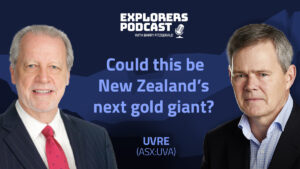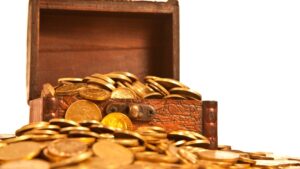Ground Breakers: Billionaire mining boss Robert Friedland calls for end of African discount in epic copper rant

Pic: Golden_Brown/iStock via Getty Images
- Check out this epic rant from billionaire mining boss Robert Friedland on the discount applied to copper miners in the DRC
- Friedland says Martians could see Congo is the best place in the world to mine copper, torches analysts on valuations and says nothing in BHP target OZ Minerals is ‘necessarily Tier 1’
- Gold miners surge as US Fed confirms ‘light’ 25bps rate hike
Robert Friedland is a legend in the mining game, a Canadian political science major whose fervour for metals led to his involvement in the discoveries of the Voisey’s Bay nickel field in Newfoundland and Labrador, and the Oyu Tolgoi copper-gold mine in Mongolia.
The Ivanhoe Mines chairman, worth US$3b according to Forbes, is no stranger to risky, far-flung or overlooked jurisdictions and exploration plays.
And his latest development is in some ways his ballsiest yet. C$15 billion capped Ivanhoe is now two years into production at the Kamoa-Kakula copper mine in the Democratic Republic of the Congo alongside its JV partner, China’s Zijin.
The largest Tier-1 development in years, the operation is a roughly 400,000tpa copper mine at an industry leading grade of almost 5%.
But a proposal to develop its third and fourth stages at a combined capital cost of ~US$4.5 billion, including a US$906m smelter which would produce 500,000t of 99% pure blister anode copper a year, would turn it into one of the world’s largest copper mines, producing 620,000tpa of copper on average over its first 10 years.
The Phase-3 expansion, to be completed in the fourth quarter of 2024, would cost around US$3b, with Ivanhoe also announcing capital estimates of US$490m and US$380m for its Platreef development in South Africa and Kipushi development in the DRC.
The project carries an NPV of US$19.1 billion at US$3.70/lb, or US$23b at spot prices of around US$4.25/lb. But that includes an 8% discount rate, something Friedland has issues with.
In his mind, that ‘African discount’ — commonly applied by analysts on account of the political risks of operating in Africa — is all bull, telling analysts in a self-described rant on Wednesday the DRC is “the most desirable location in the world to mine copper”, and taking a barely-veiled swipe at the BHP’s (ASX:BHP) $9.6 billion cash buy of OZ Minerals (ASX:OZL) in the process.
Where to start?
Friedland’s first target is the Canadian analysts.
Take it away Bob:
“So the largest mining companies in the world are throwing these NPV models out the window.
“They should be burned; they should be trashed. They should never appear again.
“The management of these banks that allow analysts to create these absurd models they should just change their minds. Because the real world value of a Tier 1 mine is much more than an NPV model and NPV modelling is not the only way to model a mine.
“The markets model great mines at a premium.
“And I think Oyu Tolgoi is going to be a Tier 1 mine, Kamoa-Kakula is already a tier 1 mine – I don’t think anything in Oz Minerals is necessarily Tier 1” (Shots. Fired. – GB)
“But in order to pay a 68% per cent premium, those buyers – BHP and Rio Tinto – must have used $US6/lb copper in their models.
“$US6/lb copper to your model on Kamoa-Kakula and you’ll begin to see how severely undervalued this asset is at the moment.”
Tech companies are next on the bill.
“You know tech companies are modelled at a 0% discount rate and gold companies are modelled at a 0% discount rate, but there isn’t going to be any technological revolution without this copper,” Friedland said.
“There isn’t going to be any electric car industry without this copper, so it no longer makes sense that analysts are using a 10% discount rate or 8% discount rate which gives you no value for this asset.
“It took 26 years to discover and build the asset. It is really, really hard to do this.
“It is literally as rare as hen’s teeth, so thank you for giving me the opportunity to tell everyone on the call that the only discount rate that makes sense for this asset is zero.”
Anything really out there?
Here’s our favourite part.
“We don’t have ice or snow, we have a lot of young kids that are desperate to work, so I continue to insist that if I came from Mars in a flying saucer and I was sent here by my masters, obviously I would go to Katanga to mine copper,” he said.
“I’m happy to tell everyone on this call there isn’t a major mining company in the world that hasn’t been in touch with us, wanting to visit the mine or figure out how to get involved in the Congo.
“No exceptions.”
First up, maybe young kids isn’t the best choice of words when it comes to mining in the Congo… not that we’re accusing Ivanhoe of anything untowards here.
Secondly, the Martians!
The Alien Theory — often propounded by basketball savant Bill Simmons to explain well-built players who would appear to an alien to be the best on the court, but often aren’t — is one of our favourites to spew out drunkenly over a can of Bushchook at a summer barbie.
The context is that Friedland reckons the DRC, ranked third last only ahead of Spain and Zimbabwe on the mining investment attractiveness index released last year by the Fraser Institute in its annual survey of mining companies, is a better bet for copper than Chile or Peru.
(As an aside, ask AVZ (ASX:AVZ) investors about the predictability of operating in the DRC.)
The two largest producers in the world, Chile and Peru have been stung by a string of suspensions and turmoil as a new left wing government in Chile and political unrest threatens to curb supply. The Las Bambas mine in Peru notably entered a suspension on Wednesday.
“When I first said that I would rather mine copper in the Congo than in Chile, I got a lot of snickers. It was written about in the Financial Times in London as an absurd statement,” Friedland said.
“But under the young 35 years old communist party member in Chile (President Gabriel Boric), you can see that the Chilean industry has been unable to develop any meaningful expansion.
“The grid in Chile is not green, they burn coal for most of the grid, they’re desperately trying to get some solar there but there’s a shortage of water. The same applies in Peru.
“As we’ve said 100 times; if my mine is 10 times the grade of your mine – and our mine is 10 times the grade of Escondida, the largest copper mine in the world – we are using a 10th of the steel, a 10th of the concrete, a 10th of the water and a 10th of the electricity, and we are generating automatically 10th of the global warming gas per unit of copper.
“It makes no sense to apply a 10% discount rate to Congolese copper production, when it’s the greenest place in the world to mine copper.”
He says that will improve further with the development of a new transport network known as the Lobito Corridor being developed by a Trafigura-led consortium. Later on Friedland returns to the theme.
“We will fix that by running tours to the mine and speaking at conferences like BMO and Bank of America, and eventually we’ll bring people into the light that this is exactly the type of asset we need if your children are ever going to live in a world that is greener and cleaner,” Friedland said.
“And it’s not just your children in rich countries, it’s Africans and South Americans and people in the developing world that also need to live and eat and survive. So I think this enterprise needs a lot more financial backing, and a much more mature and wiser method of evaluation.
“I recently tweeted out a chart showing how absurdly small the mining industry is in market capitalisation compared to the technology companies, and it’s simply because the mining companies are saddled with these crazy NPV models that don’t pay them for any value after 10 years.”
I repeat … We've had 40+ years where all the money went into broadband, or internet, or Netflix or the cloud and no money went into basic productive capacity of #metals. pic.twitter.com/HTartdKlCT
— Robert Friedland (@robert_ivanhoe) January 30, 2023
“It’s nearly impossible to create a new BHP, or a new Rio Tinto. Those companies have 50 years of reserves. They shouldn’t be modelled on an NPV basis. It makes no sense.”
“If anything needs a discount it’s anything south of the Panama Canal.”
Scorching.
Copper slides on Chinese real estate, Caterpillar
It is certainly true that the supply side of copper has been severely crimped by Chile and Peru’s struggles to recover post-Covid, amid a fraught political and investment landscape.
Codelco, Chile’s state-run copper miner and the world’s biggest standalone producer, saw output fall around 10% or 172,000t in 2022, with three major development projects well behind schedule and over budget — the US$5.6 billion El Teniente mine to the tune of 75%.
However, copper prices overnight sagged on a worse demand profile, falling 1.5% to US$9087/t.
“Copper led the complex lower as the market switched its focus away from supply disruption to signs of weaker demand. Caterpillar, one of the world’s largest makers of heavy machinery, warned that demand in China won’t be bouncing back this year,” ANZ’s John Bromhead said in a note this morning.
“This came after data showed China’s home sales continued to slump in January. The 100 biggest real estate developers saw sales fall 32.5% y/y to CNY325.3bn, according to China Real Estate Information Corp.
“Nevertheless, supply side issues appear to be worsening. China’s MMG fully closed its Las Bambas operation amid social unrest in Peru.”
Major iron ore miners were ordinary, but the materials sector lifted 0.22% after Jerome Powell, boss of the US Fed, announced a mild 25bps interest rate hike in a sign it believes last year’s hawkish approach helped stem inflation.
Gold miners went crazy, with the All Ords gold sub-index up 4.87% at 12.30pm AEDT as prices rose a startling 1.46% to US$1955.34 ($2736/oz AUD).
Evolution Mining (ASX:EVN) climbed 7.41% to lead the large cap miners, with Northern Star (ASX:NST) up 5.1%.
NST shares are now up almost 65% over the past six months to a market cap of over $15 billion.
Gold miners share prices today:

UNLOCK INSIGHTS
Discover the untold stories of emerging ASX stocks.
Daily news and expert analysis, it's free to subscribe.
By proceeding, you confirm you understand that we handle personal information in accordance with our Privacy Policy.








